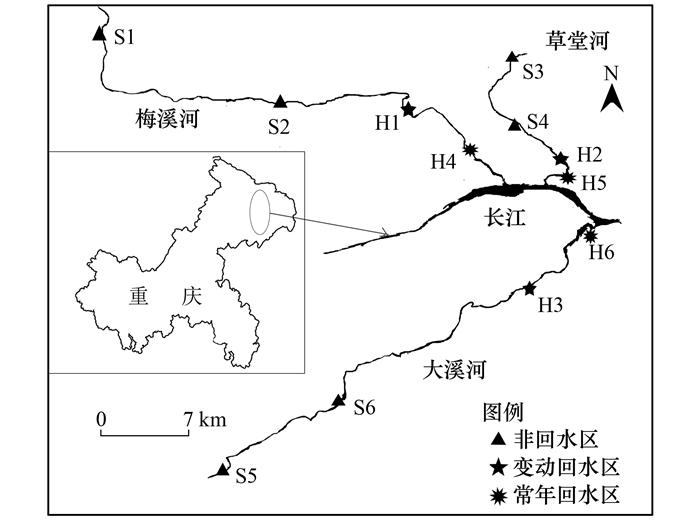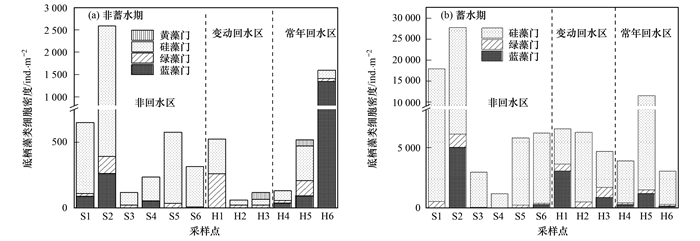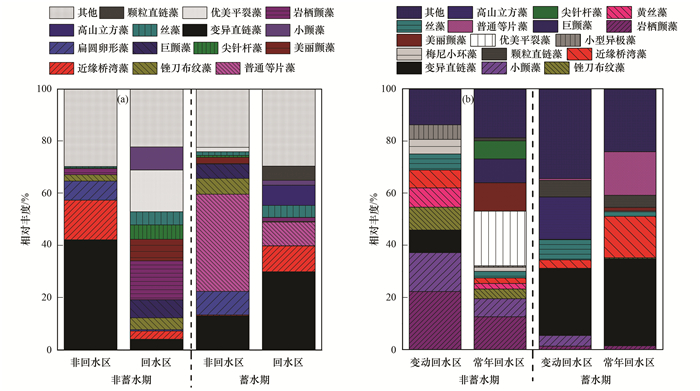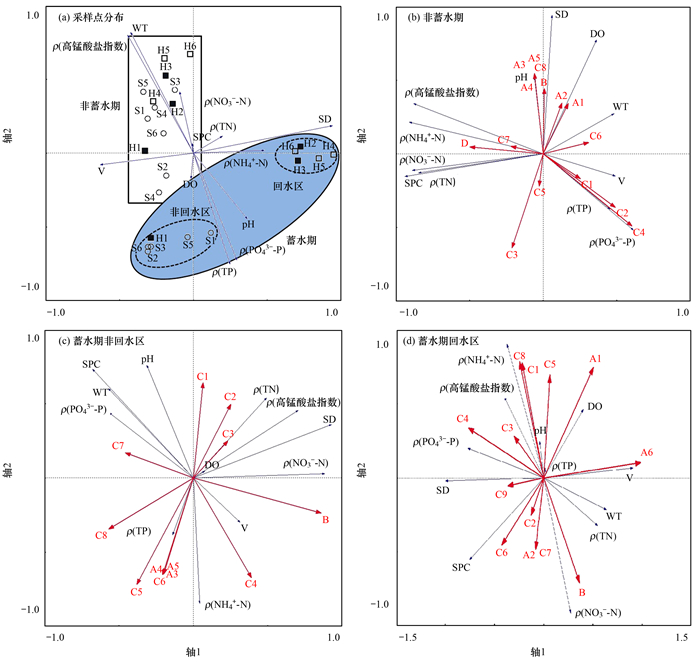三峡水库是我国特大型的人工调蓄河道型水库, 承载着防洪、发电和航运等重要的任务[1].然而, 由于水库采取枯期蓄水、汛期泄洪的“冬蓄夏排”反季节调度模式, 使得库区下游支流形成了差异显著的三类水体:①自然河流型水体(非回水区), 该河段完全不受库区蓄水影响; ②过渡型水体(变动回水区), 该河段水体在水库145 m蓄水时为河流型, 而在175 m蓄水时为类湖泊型; ③类湖泊型水体(常年回水区), 该河段水位于145 m以下, 常年受库区蓄水的影响, 形成了流速较低的水体[2].这3种不同类型的水体有着各自不同的水文环境, 且受水库蓄水的影响, 其水动力条件及水环境条件也发生显著变化[3].已有研究表明, 受145 m长期蓄水影响回水段植被结构不完整, 水土流失严重, 影响了浮游植物群落组成和结构[4], 而受175 m蓄水影响, 对回水区上游鱼类群落结构产生较大影响[5], 且在不同河段浮游植物群落结构呈现出不同的变化[6~8].这些研究表明了三峡库区不同水文情势周期蓄水对水生生态系统造成了重要的影响.
藻类是水生生态系统主要的生产者, 在水生生态系统中起着重要的作用[9].因此, 藻类常常被作为水质监测的重要指标之一.然而, 浮游藻类由于生长不固定、容易迁移和受环境影响变化大等特征, 使得其并不能准确地反映水质状况[10].相反, 底栖藻类由于更新时间短, 对河流水环境和栖息地环境质量变化反应迅速, 且群落变化趋势可预测性较强等特征常被用作河流生物监测和评价[11~13].
附石藻类作为底栖藻类的一种类型, 是指固着生长在水体各种浸没基质——石头表面上的藻类[14].由于其生物多样性丰富、样本易获取, 且对环境变化响应敏感等特点, 因此其已被作为河流生态状况的重要指示生物[15~17].然而, 目前针对三峡库区不同水文情势影响下不同水体附石藻类的研究甚少.因此, 本研究于2015年8月(非蓄水期)和2016年2月(蓄水期)对奉节地区的3条库区支流常年回水区、变动回水区与非回水区附石藻类群落组成及其影响因子进行研究.通过对库区在不同水文情势下支流不同河段附石藻类的结构及组成变化, 阐明水位变动条件下附石藻类的生态学变化特征及其影响因素, 以期为库区的水环境保护和管理提供基础依据.
1 材料与方法 1.1 研究河流状况在重庆奉节地区的3条库区支流梅溪河(31°05′~31°12′N, 109°08′~109°29′E)、草堂河(31°03′~31°08′N, 109°31′~109°34′E)和大溪河(30°46′~31°00′N, 109°15′~109°31′E)设置12个采样点(图 1), 其中非回水区和回水区各6个样点, 非回水区:S1、S2、S3、S4、S5和S6;变动回水区:H1、H2和H3;常年回水区:H4、H5和H6, 并于非蓄水期(2015年8月)和蓄水期(2016年2月)对样点进行采样.为了便于比较, 每次采样均为当月中旬, 尽量选晴天进行.

|
图 1 三峡库区支流样点分布示意 Fig. 1 Sampling sites in the tributaries of the Three Gorges Reservoir |
各采样点的水温(WT)、pH、电导率(SPC)、溶解氧(DO)、氧化还原电位(ORP)、浊度(Tur)和水下光照(PAR)等参数均采用多参数水质分析仪DS5/DS5X(Hydrolab, 美国)现场测定; 透明度(SD)用塞氏盘测量; 水体流速用国产LS45A型旋杯式流速仪现场测定.各样点取混合水样带回实验室, 参照文献[18]的方法, 并用Flowsys流动分析仪(SYSTEA, 意大利)测定以下化学指标:总氮(TN)、氨氮(NH4+-N)、硝氮(NO3--N)、总磷(TP)、正磷酸盐(PO43--P)和高锰酸盐指数.
1.3 附石藻类采集、定性与定量分析附石藻类采集依照美国环保署(EPA)的采样方法进行采集[19].将采集的附石藻类样品混匀, 分两份进行保存, 一份取50 mL加入鲁哥氏固定液固定, 在Nikon E-Ci光学显微镜(Nikon, 日本)下观察和统计, 得到硅藻以外的其他藻类的定性数据; 另一份取50 mL藻液加入福尔马林固定, 经酸处理后分别在1 000倍油镜下和扫描电子显微镜下对硅藻进行鉴定, 获得硅藻定性数据.藻类鉴定参考文献[20~23].藻类定量分析采取浮游植物计数框进行计数, 获得的各样点藻类个体数总和, 最后换算为单位面积石块上的藻密度(单位:ind.·m-2)[18].
1.4 数据分析用Excel对数据进行统计整理, 用Origin 8.5作图.用SPSS 22.0软件(IBM)分析检验非蓄水期与蓄水期附石藻类组成在不同河段的差异显著性.用Canoco for Windows 4.5对物种数据进行除趋势对应分析(DCA), 4个轴最大梯度大于4.0, 选用典范对应分析(CCA); 如果小于3.0, 选用冗余分析(RDA).本研究中4个轴最大梯度均小于3, 故采用RDA(冗余分析)进行物种数据与环境因子的排序分析.
2 结果与分析 2.1 蓄水期与非蓄水期的理化因子变化不同水文期环境因子变化如表 1所示.在非蓄水期, 总氮、氨氮、硝氮、总磷、正磷酸盐、高锰酸盐指数和溶氧分别为0.27~2.4、0.01~0.11、0.38~2.23、0.04~0.12、0.001~0.118、0.29~3.93和7.26~18.32 mg·L-1, 而蓄水期, 总氮、氨氮、硝氮、总磷、正磷酸盐、高锰酸盐指数和溶氧分别为1.11~2.07、0.01~0.84、0.57~1.47、0.09~0.13、0.080~0.127、0.01~0.09和8.87~13.31 mg·L-1.总氮、氨氮、硝氮、正磷酸盐指数、溶氧和水温等参数在非蓄水期波动较大, 在蓄水期则相对较小; 水温和高锰酸盐指数在非蓄水期高于蓄水期.回水区正磷酸盐浓度在非蓄水期低于蓄水期; 除H1样点蓄水期与非蓄水期流速和透明度没有明显差异, 回水区其余样点则表现出蓄水期流速低于非蓄水期, 而回水区透明度则表现为非蓄水期低于蓄水期.非蓄水期, 变动回水区正磷酸盐浓度高于常年回水区, 变动回水区pH和溶氧却低于常年回水区; 蓄水期, 变动回水区溶氧高于常年回水区, 且蓄水期变动回水区pH高于非蓄水期.
|
|
表 1 非蓄水期和蓄水期各样点的环境因子 Table 1 Environmental factors at each sampling site under the high and level hydrological regimes |
2.2 蓄水期和非蓄水期各河段附石藻类的物种组成
3条支流共发现附石藻类103种, 隶属4门45属, 其中非回水区67种, 隶属3门34属, 回水区82种(常年回水区64种, 变动回水区41种), 隶属4门34属.蓄水期[图 2(b)]藻密度显著高于非蓄水期[图 2(a)], 且蓄水期以硅藻占据明显优势.

|
图 2 非蓄水与蓄水期3条支流各样点附石藻细胞密度 Fig. 2 Density of epilithic algae at each sampling site during the non-storage and storage periods |
非回水区, 非蓄水期和蓄水期均以硅藻占优势, 硅藻平均藻密度分别为643 ind.·m-2和9 088 ind.·m-2.回水区, 非蓄水期在H1和H2样点绿藻和硅藻为优势种, 在H1样点藻密度均为262 ind.·m-2, 在H2样点则分别为22 ind.·m-2和39 ind.·m-2, H3以绿藻、硅藻和黄藻为优势种, 藻密度分别为22、44和52 ind.·m-2, H4、H5和H6均以蓝藻、绿藻和硅藻为优势种, 平均藻密度分别为491、69和175 ind.·m-2; 而蓄水期H1样点以蓝藻和硅藻为优势种, 藻密度分别为3 037 ind.·m-2和2 928 ind.·m-2, 其余样点均以硅藻占绝对优势, 平均藻密度为4 643 ind.·m-2.
在非蓄水期变动回水区, 主要以绿藻和硅藻占优势, 平均藻密度为102 ind.·m-2和115 ind.·m-2, 而在常年回水区则为蓝藻和硅藻占优势, 平均藻密度为491 ind.·m-2和175 ind.·m-2; 在蓄水期变动回水区, 除H1样点以蓝藻和硅藻为优势种外, H2和H3样点以硅藻占绝对优势, 藻密度为5 746 ind.·m-2和2 972 ind.·m-2, 而常年回水区, 各样点均以硅藻占优势, 平均藻密度达5 404 ind.·m-2.
2.3 蓄水期和非蓄水期各河段附石藻类的优势种组成进一步以相对丰度大于5%划分优势种, 发现蓄水期和非蓄水期不同河段优势藻种17种[图 3(a)].在非蓄水期, 非回水区优势种为变异直链藻、近缘桥弯藻和扁圆卵形藻, 相对丰度分别为42.08%、15.03%和7.32%;回水区优势种为巨颤藻(6.95%)、岩栖颤藻(14.94%)、美丽颤藻(8.28%)、尖针杆藻(5.47%)、丝藻(5.08%)、优美平裂藻(15.98%)和小颤藻(8.88%).在蓄水期, 非回水区优势种为变异直链藻(12.97%)、扁圆卵形藻(9.02%)、普通等片藻(37.33%)、锉刀布纹藻(6.08%)和巨颤藻(5.51%); 而回水区优势种为变异直链藻(29.81%)、普通等片藻(99.11%)、近缘桥弯藻(9.9%)、高山立方藻(7.72%)和颗粒直链藻(5.43%), 其中蓄水期变异直链藻与普通等片藻在非回水区和回水区均为优势种.

|
(a)非回水区和回水区;(b)回水区 图 3 不同水位期非回水区和回水区及变动回水区和常年回水区优势种相对丰度 Fig. 3 Relative abundance of dominant species in the natural reaches and the backwater reaches, and in the perennial backwater sections and the fluctuating backwater sections under different hydrological regimes |
对变动回水区和常年回水区优势藻种研究发现[图 3(b)], 在非蓄水期变动回水区, 优势藻种为岩栖颤藻(22.36%)、小颤藻(14.89%)、变异直链藻(8.67%)、锉刀布纹藻(8.66%)、黄丝藻(7.41%)、近缘桥弯藻(6.78%)、丝藻(6.16%)、梅尼小环藻(5.53%)和小型异极藻(5.53%), 而常年回水区, 优势种则为优美平裂藻(20.97%)、岩栖颤藻(12.62%)、美丽颤藻(10.87%)、巨颤藻(9.13%)、尖针杆藻(6.99%)和小颤藻(6.99%).蓄水期变动回水区, 优势种为变异直链藻(25.83%)、高山立方藻(16.29%)、丝藻(7.76%)和颗粒直链藻(6.36%), 而常年回水区, 优势种为变异直链藻(33.41%)、普通等片藻(16.76%)和近缘桥弯藻(15.96%).非蓄水期岩栖颤藻和小颤藻在变动回水区和常年回水区均为优势种; 蓄水期变异直链藻在变动回水区和常年回水区均为优势种.
2.4 不同时期各河段优势藻种与环境因子的RDA分析对样点和环境因子进行RDA分析发现[图 4(a)], 各样点受蓄水影响较大, 蓄水期与非蓄水期出现明显的分区.非蓄水期非回水区、变动回水区和常年回水区环境因子没有明显差异, 而在蓄水期非回水区样点和回水区样点出现明显差异, 其中H1样点由于透明度明显降低, 而流速则增加, 从而使得H1样点偏离其余回水区样点.

|
图 4 非蓄水期和蓄水期各河段主要优势种与环境因子的RDA排序图 Fig. 4 RDA ordination diagram between dominant species and environmental factors in different river sections and during the different hydrological regime |
对非蓄水期、蓄水期非回水区和蓄水期回水区优势藻种(其物种名称及代码见表 2)与环境因子关系分析表明, 在非蓄水期、蓄水期的非回水区和蓄水期的回水区, 物种与环境因子排序轴的相关性系数均为1, 前两轴的特征值分别为0.497和0.309、0.647和0.275、0.932和0.052, 且前两轴对数据的解释量分别达到了80.7%、92.2%和98.4%(表 3).在非蓄水期, 蓝藻门优势种物种(A1:岩栖颤藻、A2:小颤藻、A3:美丽颤藻、A4:巨颤藻和A5:优美平裂藻)、绿藻门优势种(B:丝藻)和硅藻门优势种(C8:普通等片藻)与透明度和溶氧呈正相关关系, 而与正磷酸盐和总磷浓度呈负相关; 而硅藻门优势种(C1:近缘桥弯藻、C2:小型异极藻、C3:扁圆卵形藻、C4:变异直链藻和C5:梅尼小环藻)则刚好相反; C7(尖针杆藻)和D(黄丝藻)与高锰酸盐指数、电导率、总氮、氨氮和硝氮浓度呈正相关, 与水温和流速呈负相关, 而C6(锉刀布纹藻)则刚好相反[图 4(b)].总体而言, 在非蓄水期, 黄藻受氮元素和水温等环境因子的影响较大, 而在水温、透明度和溶氧高的情况下有利于蓝藻的生长, 在低温和磷元素浓度高的情况下有利于大部分硅藻的生长.
|
|
表 2 RDA分析中的附石藻类优势藻种代码 Table 2 Codes of dominant species of epilithic algae for RDA |
|
|
表 3 蓄水期和非蓄水期各河段主要优势种与环境因子的RDA分析 Table 3 RDA analysis between dominant species and environmental factors in the different river sections and under the different hydrological regime |
在蓄水期非回水区, A3、A4、A5、B、C4、C5、C6(高山立方藻)和C8与氨氮和总磷浓度呈正相关关系, 而C1、C2和C3则与正磷酸盐浓度呈正相关关系, 与总磷浓度呈负相关关系[图 4(c)]; 在蓄水期回水段, A1、C1、C3、C4、C5和C8与高锰酸盐指数、氨氮和总磷浓度呈正相关关系, 与总氮和硝氮浓度呈负相关关系, 而A2、B、C2、C6和C7则刚好相反; A6与流速呈正相关关系, 与透明度呈负相关关系, 而C9(颗粒直链藻)则刚好相反[图 4(d)].
3 讨论贾兴焕等[24]对库区支流香溪河附石藻类时空动态的研究表明, 香溪河附石藻类密度冬、春季节高于夏、秋季节.本研究对奉节地区库区支流不同河段附石藻类组成及分布情况的调查中也发现非蓄水期的附石藻类细胞密度明显低于蓄水期(图 2), 表明冬季温度有利于附石藻类的生长.刘奕伶等[25]对支流古夫河的研究中发现在不同时期优势种差异显著.张蔚珍等[26]对西湖附石藻类的研究中发现不同季节附石藻类优势种不同.在本研究也发现非蓄水期与蓄水期在不同河段优势藻种有明显差异(P < 0.01).在非蓄水期非回水区以硅藻占优势, 回水区则为蓝藻、绿藻和硅藻为优势种; 在蓄水期非回水区和回水区均以附石硅藻占据明显优势, 主要优势种为变异直链藻和普通等片藻.非回水区蓄水期和非蓄水期变异直链藻和扁圆卵形藻均作为优势种出现, 主要优势藻种无明显差异[27].而回水区不同时期优势藻种出现差异, 对常年回水区和变动回水区进一步分析发现, 在非蓄水期两个河段均以颤藻占据明显优势; 在蓄水期主要优势种均为变异直链藻(图 3).这些结果表明了三峡库区水文情势变动对附石藻类群落组成具有显著的影响, 使得不同水情期主要优势藻种不同, 对环境变化呈现出不同的指示特征.
已有研究发现水环境的变化对附石藻类的组成和结构有直接影响[28].在浅水湖泊中附石藻类的空间异质性受水体中氮、磷等营养水平的制约[29, 30], TP浓度达到0.04 mg·L-1时敏感硅藻大量减少, 达到0.065 mg·L-1时敏感硅藻几乎消失, 在0.082 mg·L-1时硅藻群落结构则发生显著改变[14].在河流中, 氮和磷浓度也是影响底栖藻类群落变动的主要因子[31].此外, 水体中氮、磷浓度增加, 导致了附植藻类的生物量显著增加[32].对丹江口水库的研究中发现, 在水库泄水后总磷浓度下降[33].本研究也发现总磷浓度在蓄水期高于非蓄水期, 总氮浓度差异不大(表 1), 然而, 附石藻类细胞密度在蓄水期远高于非蓄水期(图 2), 表明库区附石藻类群落结构变化与总磷浓度的变化显著相关, 支持了总磷浓度增加会增加硅藻的百分比[14]与附着藻类生物量增加的结论[34, 35].氨氮可以通过食物链的传递作用决定以藻类为食的寡食者和沉积物收集者的密度, 从而反作用于底栖藻类, 导致底栖藻类的分布和数量明显发生变化[36].前人研究也发现氨氮在蓝藻水华形成过程中具有重要作用[37].室内研究中则发现在所设定的浓度内氨氮能够抑制藻类的生长, 且浓度越高, 抑制越明显[38].同时斜生栅藻对氨氮浓度为2 mg·L-1和4 mg·L-1时具有较高的去除率[39].本研究发现蓄水期与非蓄水期氨氮并未表现出明显的差异(表 1), 表明氨氮对库区底栖藻类分布和数量并未有显著的影响. Potapova等[40]认为硅藻群落的变化是水体电导率和营养盐综合效应的结果.本研究RDA分析结果也发现总磷、正磷酸盐浓度和电导率的增加均有助于增加硅藻细胞密度(图 4), 表明电导率等是影响附石藻类群落的重要环境因子[41~43]. Leira等[44]在研究中发现硅藻的组成与温度关系密切, 在本研究发现非蓄水期水温在24.37~30.59℃, 而蓄水期水温则在10.12~13.88℃之间, 表明在冬季温度较低可能更适合附石藻类尤其是硅藻的生长[24], 而在夏季温度较高附石藻类密度较低, 优势藻种则为蓝藻、绿藻和硅藻[45], 在本研究中也发现相似的结果, 即非蓄水期(2015年8月)蓝、绿、硅藻为共优种, 蓄水期(2016年2月)主要以硅藻为优势种.
在非回水区不同时期优势藻种无明显差异, 但主要优势藻种发生了演替现象, 推测在非蓄水期非回水区水位较低、水体搅动较大, 比较适宜变异直链藻生活[43], 而在蓄水期水位升高, 使得更适宜于持续层水体的普通等片藻占据明显优势[46], 使得主要优势藻种由非蓄水期的变异直链藻演替为蓄水期的普通等片藻.
在回水区非蓄水期优势藻种为颤藻、丝藻和尖针杆藻, 然而, 由于蓄水影响使得回水区在蓄水期流速显著降低, 主要优势藻种为变异直链藻和桥弯藻, 这与在缓流的情况下变异直链藻有升高趋势的结果相一致[47]. Bennion[48]的研究表明, 针杆藻主要受透光条件影响, 受营养的影响较小, 本研究中非蓄水期回水区透明度比非回水区高, 表明透明度的增加有利于针杆藻的生长.总之, 从3条支流水质来看, 3条支流氮、磷浓度已经达到富营养化标准[49].有研究表明各物种在不同区域内表现出特定的物种-环境关系, 会导致同一物种在不同区域呈现不同的指示特征[50, 51].
4 结论(1) 奉节地区3条支流, 共鉴定出附石藻类103种, 隶属4门45属, 其中非回水区67种, 回水区82种(常年回水区64种, 变动回水区41种).
(2) 非蓄水期, 非回水区优势种为变异直链藻等硅藻, 回水区优势种为巨颤藻等蓝藻; 蓄水期非回水区和回水区均以变异直链藻等硅藻为优势种.非回水区蓄水期和非蓄水期优势藻种差异不大, 而回水区则变化显著.
(3) 附石藻类群落组成受众多环境因子共同作用, 而各样点优势藻种细胞密度变化主要受氮、磷元素浓度变化的影响.
| [1] | Stone R. Three gorges dam:into the unknown[J]. Science, 2008, 321(5889): 628-632. DOI:10.1126/science.321.5889.628 |
| [2] | Sha Y K, Wei Y P, Li W P, et al. Artificial tide generation and its effects on the water environment in the backwater of Three Gorges Reservoir[J]. Journal of Hydrology, 2015, 528: 230-237. DOI:10.1016/j.jhydrol.2015.06.020 |
| [3] |
杨正健, 刘德富, 纪道斌, 等. 三峡水库172.5 m蓄水过程对香溪河库湾水体富营养化的影响[J]. 中国科学:技术科学, 2010, 53(4): 358-369. Yang Z J, Liu D F, Ji D B, et al. Influence of the impounding process of the Three Gorges Reservoir up to water level 172.5 m on water eutrophication in the Xiangxi Bay[J]. Science China Technological Sciences, 2010, 53(4): 1114-1125. |
| [4] |
陈淼, 苏晓磊, 黄慧敏, 等. 三峡库区支流生境因子对库区蓄水的响应[J]. 生态学报, 2018, 38(4): 1478-1486. Chen M, Su X L, Huang H M, et al. Response of habitat factors to reservoir impoundment in tributaries in the Three Gorges Reservoir Region[J]. Acta Ecologica Sinica, 2018, 38(4): 1478-1486. |
| [5] |
杨志, 唐会元, 朱迪, 等. 三峡水库175 m试验性蓄水期库区及其上游江段鱼类群落结构时空分布格局[J]. 生态学报, 2015, 35(15): 5064-5075. Yang Z, Tang H Y, Zhu D, et al. Spatiotemporal patterns of fish community structures in the Three Gorges Reservoir and its upstream during the 175-m-deep impoundment[J]. Acta Ecologica Sinica, 2015, 35(15): 5064-5075. |
| [6] |
姜伟, 周川, 纪道斌, 等. 三峡库区澎溪河与磨刀溪电导率等水质特征与水华的关系比较[J]. 环境科学, 2017, 38(6): 2326-2335. Jiang W, Zhou C, Ji D B, et al. Comparison of relationship between conduction and algal bloom in Pengxi River and Modao River in Three Gorges Reservoir[J]. Environmental Science, 2017, 38(6): 2326-2335. |
| [7] |
杨浩, 曾波, 孙晓燕, 等. 蓄水对三峡库区重庆段长江干流浮游植物群落结构的影响[J]. 水生生物学报, 2012, 36(4): 715-723. Yang H, Zeng B, Sun X Y, et al. Effect of impoundment on community structure of the phytoplankton in the main stream of the Three Gorges Reservoir of Chongqing[J]. Acta Hydrobiologica Sinica, 2012, 36(4): 715-723. |
| [8] |
张晟, 刘景红, 黎莉莉, 等. 三峡水库成库初期营养盐与浮游植物分布特征[J]. 环境科学, 2006, 27(6): 1056-1061. Zhang S, Liu J H, Li L L, et al. Distribution features of nutrient and phytoplankton in incipient Three Gorges Reservoir[J]. Chinese Journal of Environmental Science, 2006, 27(6): 1056-1061. |
| [9] | Cardinale B J, Palmer M A, Collins S L. Species diversity enhances ecosystem functioning through interspecific facilitation[J]. Nature, 2002, 415(6870): 426-429. DOI:10.1038/415426a |
| [10] | Jia Y H, Dan J, Zhang M, et al. Growth characteristics of algae during early stages of phytoplankton bloom in Lake Taihu, China[J]. Journal of Environmental Sciences, 2013, 25(2): 254-261. DOI:10.1016/S1001-0742(12)60058-8 |
| [11] | Round F E. Diatoms in river water-monitoring studies[J]. Journal of Applied Phycology, 1991, 3(2): 129-145. DOI:10.1007/BF00003695 |
| [12] | Van Dam H, Mertens A, Sinkeldam J. A coded checklist and ecological indicator values of freshwater diatoms from the Netherlands[J]. Netherland Journal of Aquatic Ecology, 1994, 28(1): 117-133. DOI:10.1007/BF02334251 |
| [13] | Chessman B, Growns I, Currey J, et al. Predicting diatom communities at the genus level for the rapid biological assessment of rivers[J]. Freshwater Biology, 1999, 41(2): 317-331. DOI:10.1046/j.1365-2427.1999.00433.x |
| [14] | Smucker N J, Becker M, Detenbeck N E, et al. Using algal metrics and biomass to evaluate multiple ways of defining concentration-based nutrient criteria in streams and their ecological[J]. Ecological Indicators, 2013, 32: 51-61. DOI:10.1016/j.ecolind.2013.03.018 |
| [15] | Black R W, Moran P W, Frankforter J D. Response of algal metrics to nutrients and physical factors and identification of nutrient thresholds in agricultural streams[J]. Environmental Monitoring and Assessment, 2011, 175(1-4): 397-417. DOI:10.1007/s10661-010-1539-8 |
| [16] | Potapova M, Charles D F. Diatom metrics for monitoring eutrophication in rivers of the United States[J]. Ecological Indicators, 2007, 7(1): 48-70. DOI:10.1016/j.ecolind.2005.10.001 |
| [17] | Porter S D, Mueller D K, Spahr N E, et al. Efficacy of algal metrics for assessing nutrient and organic enrichment in flowing waters[J]. Freshwater Biology, 2008, 53(5): 1036-1054. DOI:10.1111/j.1365-2427.2007.01951.x |
| [18] | 国家环境保护总局. 水和废水监测分析方法[M]. (第四版). 北京: 中国环境科学出版社, 2002. |
| [19] | Lazorchak J M, Klemm D J, Peck D V. Environmental monitoring and assessment program- surface waters: field operations and methods for measuring the ecological condition of wadeable streams[R]. EPA/620/R-94/004F, Washington: EPA, 1998.119-132. |
| [20] |
胡鸿钧, 魏印心. 中国淡水藻类:系统、分类及生态[M]. 北京: 科学出版社, 2006. Hu H J, Wei Y X. The freshwater algae of China:systematics, taxonomy and ecology[M]. Beijing: Science Press, 2006: 300-416. |
| [21] | Krammer K, Lange-Bertalot H. Bacillariophyceae 3.teil: centrales, fragilariaceae, eunotiaceae[A]. In: Ettl H, Gerloff J, Heynig H, et al (Eds.). Süsswasserflora von Mitteleuropa[M]. Jena: Gustav Fischer Verlag, 1991.1-576. |
| [22] | 朱蕙忠, 陈嘉佑. 中国西藏硅藻[M]. 北京: 科学出版社, 2000. |
| [23] | 中国科学院中国孢子植物志编辑委员会. 中国淡水藻志(第一至二十卷)[M]. 北京: 科学出版社, 1988. |
| [24] |
贾兴焕, 吴乃成, 唐涛, 等. 香溪河水系附石藻类的时空动态[J]. 应用生态学报, 2008, 19(4): 881-886. Jia X H, Wu N C, Tang T, et al. Spatiotemporal variation of epilithic algae in Xiangxi River system[J]. Chinese Journal of Applied Ecology, 2008, 19(4): 881-886. |
| [25] |
刘奕伶, 葛继稳, 李艳元, 等. 古夫河着生藻类优势种体积与水质因子的相关性研究[J]. 中国环境科学, 2015, 35(7): 2182-2191. Liu Y L, Ge J W, Li Y Y, et al. Correlations between the volume of dominant periphytic algae species and the water quality parameters in Gufu River[J]. China Environmental Science, 2015, 35(7): 2182-2191. DOI:10.3969/j.issn.1000-6923.2015.07.044 |
| [26] |
张蔚珍, 于佳, 夏午来, 等. 西湖湖西浮游与着生藻类季节变化及相互关系[J]. 水生生物学报, 2017, 41(4): 896-903. Zhang W Z, Yu J, Xia W L, et al. Seasonal variation of phytoplankton and periphyton and their relationships in the western region of the west lake[J]. Acta Hydrobiologica Sinica, 2017, 41(4): 896-903. |
| [27] |
杨燕君, 徐沙, 刘瑞, 等. 基于附石藻类生物完整性指数对汝溪河水生态系统健康的评价[J]. 水生生物学报, 2017, 41(1): 228-237. Yang Y J, Xu S, Liu R, et al. Using epilithic algae assemblages to assess stream heath of the Ruxi River, China[J]. Acta Hydrobiologica Sinica, 2017, 41(1): 228-237. |
| [28] | Muscio C. The diatom pollution tolerance index: assigning tolerance values[R]. Austin: Watershed Protection & Development Review Department, 2002. |
| [29] |
汤婷, 任泽, 唐涛, 等. 基于附石硅藻的三峡水库入库支流氮、磷阈值[J]. 应用生态学报, 2016, 27(8): 2670-2678. Tang T, Ren Z, Tang T, et al. Total nitrogen and total phosphorus thresholds for epilithic diatom assemblages in inflow tributaries of the Three Gorges Reservoir, China[J]. Chinese Journal of Applied Ecology, 2016, 27(8): 2670-2678. |
| [30] |
宋玉芝, 薛艳, 徐建强, 等. 太湖附泥藻类生物量空间分布及其与环境营养盐的关系[J]. 环境科学学报, 2017, 37(11): 4178-4186. Song Y Z, Xue Y, Xu J Q, et al. Spatial distribution of epipelic algal biomass and its relationship with the environmental nutrients in Lake Taihu[J]. Acta Scientiae Circumstantiae, 2017, 37(11): 4178-4186. |
| [31] | Leland H V, Porter S D. Distribution of benthic algae in the upper Illinois River basin in relation to geology and land use[J]. Freshwater Biology, 2010, 44(2): 279-301. |
| [32] | Blumenshine S C, Vadeboncoeur Y, Lodge D M, et al. Benthic-pelagic links:responses of benthos to water-column nutrient enrichment[J]. Journal of the North American Benthological Society, 1997, 16(3): 466-479. DOI:10.2307/1468138 |
| [33] |
李冰, 王亚, 郑钊, 等. 丹江口水库调水前后表层沉积物营养盐和重金属时空变化[J]. 环境科学, 2018, 39(8): 3591-3600. Li B, Wang Y, Zheng Z, et al. Temporal and spatial changes in sediment nutrients and heavy metals of the Danjiangkou Reservoir before and after water division of the mid-route project[J]. Environmental Science, 2018, 39(8): 3591-3600. |
| [34] | Pizarro H, Vinocur A, Tell G. Periphyton on artificial substrata from three lakes of different trophic status at Hope Bay (Antarctica)[J]. Polar Biology, 2002, 25(3): 169-179. |
| [35] | Quinlan E L, Phlips E J, Donnelly K A, et al. Primary producers and nutrient loading in Silver Springs, FL, USA[J]. Aquatic Botany, 2008, 88(3): 247-255. DOI:10.1016/j.aquabot.2007.11.003 |
| [36] |
渠晓东, 曹明, 邵美玲, 等. 雅砻江(锦屏段)及其主要支流的大型底栖动物[J]. 应用生态学报, 2007, 18(1): 158-162. Qu X D, Cao M, Shao M L, et al. Macrobenthos in Jinping reach of Yalongjiang River and its main tributaries[J]. Chinese Journal of Applied Ecology, 2007, 18(1): 158-162. DOI:10.3321/j.issn:1001-9332.2007.01.027 |
| [37] |
彭宇科, 路俊玲, 陈慧萍, 等. 蓝藻水华形成过程对氮磷转化功能细菌群的影响[J]. 环境科学, 2018, 39(11): 4938-4945. Peng Y K, Lu J L, Chen H P, et al. Dynamic changes of nitrogen-transforming and phosphorus-accumulating bacteria along with the formation of cyanobacterial blooms[J]. Environmental Science, 2018, 39(11): 4938-4945. |
| [38] |
刘炎, 石小荣, 崔益斌, 等. 高浓度氨氮胁迫对纤细裸藻的毒性效应[J]. 环境科学, 2013, 34(11): 4386-4391. Liu Y, Shi X R, Cui Y B, et al. Toxic effects of high concentrations of ammonia on Euglena gracilis[J]. Environmental Science, 2013, 34(11): 4386-4391. |
| [39] |
刘盼, 贾成霞, 杨慕, 等. 2种微藻对养殖水体中氨氮和亚硝态氮的净化作用[J]. 水产科学, 2018, 37(3): 389-393. Liu P, Jia C X, Yang M, et al. Removal of ammonia and nitrite nitrogen in aquaculture water by two species of microalgae[J]. Fisheries Science, 2018, 37(3): 389-393. |
| [40] | Potapova M, Charles D F. Distribution of benthic diatoms in U. S. rivers in relation to conductivity and ionic composition[J]. Freshwater Biology, 2010, 48(8): 1311-1328. |
| [41] | Walker C E, Pan Y D. Using diatom assemblages to assess urban stream conditions[J]. Hydrobiologia, 2006, 561(1): 179-189. DOI:10.1007/s10750-005-1613-3 |
| [42] | Chen X, Zhou W Q, Pickett S T A, et al. Diatoms are better indictors of stream conditions:A case study in Beijing, China[J]. Ecological Indicators, 2016, 60(1): 265-274. |
| [43] | Leland H V. Distribution of phytobenthos in the Yakima River Basin, Washington, in relation to geology, land use and other environmental factors[J]. Canadian Journal of Fisheries and Aquatic Sciences, 1995, 52(5): 1108-1129. DOI:10.1139/f95-108 |
| [44] | Leira M, Sabater S. Diatom assemblages distribution in Catalan rivers, NE Spain, in relation to chemical and physiographical factors[J]. Water Research, 2005, 39(1): 73-82. DOI:10.1016/j.watres.2004.08.034 |
| [45] | Eloranta P V. Periphyton growth and diatom community structure in a cooling water pond[J]. Hydrobiologia, 1982, 96(3): 253-265. DOI:10.1007/BF00010616 |
| [46] | Reynolds C S. The ecology of freshwater phytoplankton[M]. Cambridge: Cambridge University Press, 1984. |
| [47] |
臧小苗, 张远, 林佳宁, 等. 2009年与2014年太子河流域附石藻群落结构变化及其与水环境的关系[J]. 环境科学研究, 2018, 31(6): 1057-1067. Zang X M, Zhang Y, Lin J N, et al. Variation of periphyton community structure in 2009, 2014 and their relationship with environmental factors in Taizi River basin[J]. Research of Environmental Sciences, 2018, 31(6): 1057-1067. |
| [48] | Bennion H. A diatom-phosphorus transfer function for shallow, eutrophic ponds in southeast England[J]. Hydrobiologia, 1994, 275-276(1): 391-410. DOI:10.1007/BF00026729 |
| [49] | GB 3838-2002, 地表水环境质量标准[S]. |
| [50] | Chambers P A, Culp J M, Roberts E S, et al. Development of environmental thresholds for streams in agricultural watersheds[J]. Journal of Environmental Quality, 2012, 41(1): 1-6. |
| [51] | Lougheed V L, Parker C A, Stevenson R J. Using non-linear responses of multiple taxonomic groups to establish criteria indicative of wetland biological condition[J]. Wetlands, 2007, 27(1): 96-109. DOI:10.1672/0277-5212(2007)27[96:UNROMT]2.0.CO;2 |
 2019, Vol. 40
2019, Vol. 40


